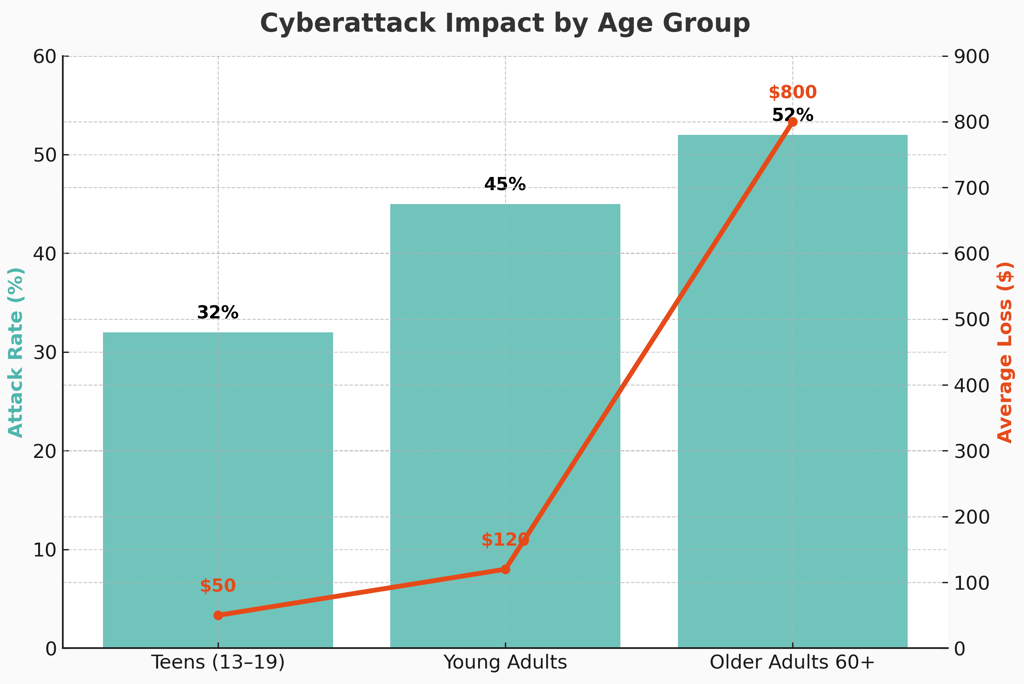Cyberattack Risks by Age Group: Why Our Intergenerational Model Matters More Than Ever
Blog post description.
9/5/20253 min leer


The Problem That Bridges Generations
Cyberattacks don’t discriminate by age — they target teens experimenting online, young adults managing finances, and older adults navigating technology that’s evolved faster than any other tool in human history.
But here’s the twist: while the attack rate may vary, the impact on each group can be drastically different.
For example, the average loss for a senior victim is often 15 times higher than that of a teen. And for young people, the losses may be smaller in dollars, but the breach of trust, privacy violations, and emotional damage can be just as lasting.
The Data: Cyberattacks Are a Shared Threat
Below is our custom chart illustrating the reality:
What it shows:
Attack Rate (%): How many people in each age group experienced at least one cyberattack last year.
Average Loss ($): How much money victims in each group lost on average.
Why This Matters
Cyberattacks against older adults are:
More financially devastating due to larger savings and assets.
More likely to involve identity theft or long-term financial harm.
Often underreported, making the numbers above likely underestimates.
For younger generations, while dollar losses may be lower:
They often face account takeovers that spread to friends and family.
Personal data leaks can haunt them for years.
Early negative experiences online can limit digital confidence.
How Our Intergenerational Approach Fits In
Our nonprofit bridges this gap through two-way teaching:
Young Digital Mentors – receive training on safe online behavior, scam detection, and digital empathy before mentoring.
Older Adult Learners – gain not only tech skills but also practical strategies for identifying, preventing, and responding to cyber threats.
What Happens in Practice
Example 1: Teen Mentor Teaches Scam Spotting
A 17-year-old volunteer teaches her older adult mentee how to:
Hover over suspicious links.
Check website domains for authenticity.
Recognize urgent language in scam emails.
Example 2: Older Adult Shares Life Experience
During the same session, the mentee shares:
How scammers manipulate emotions through fear and urgency.
The importance of slowing down before reacting — a life skill teens can apply outside the digital world too.
The Results We’ve Seen
Older adults in our program report a 40% increase in confidence in handling unsolicited messages.
Youth mentors develop leadership skills and learn to see cybersecurity as a shared community responsibility.
Intergenerational pairs often maintain friendships beyond the program, building a human network of defense against online crime.
The Emotional Impact
One mentor said:
“I thought I was just teaching tech skills. But I realized I was helping someone protect their life savings — and she was teaching me to slow down and think before I click.”
An older adult participant shared:
“I feel safer online now, but I also feel connected. Before, I thought I had to figure it out alone.”
Cybersecurity Lessons That Cross Generations
We focus on shared skill-building:
Recognizing phishing attempts.
Creating and managing strong passwords.
Understanding two-factor authentication.
Spotting fake news and misinformation.
Reporting scams to proper authorities.
Why This Model Works
Cybersecurity is most effective when:
Information is relevant – Young people learn about scams targeting them (e.g., gaming account hacks), older adults learn about investment and healthcare scams.
Trust is established – People are more likely to share suspicious messages with someone they know and trust.
Learning is active – Both generations practice scenarios in real time, reinforcing skills.
Advocating for Wider Adoption
This isn’t just a feel-good program — it’s a strategy worth scaling:
Every community could create intergenerational cyber safety teams.
Schools could incorporate senior mentorship as part of tech classes.
Libraries could host ongoing drop-in clinics led by trained youth volunteers.
Takeaway
Cyber threats are evolving every day. But so can our defenses — if we combine the energy and tech fluency of youth with the wisdom and caution of older adults.
Together, we can:
Reduce victimization rates.
Lower average financial losses.
Build a stronger, safer online community.

